Tit (bird)
| Tit | |
|---|---|
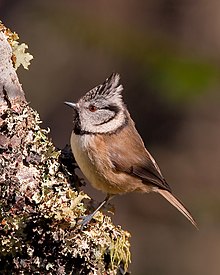
| |
| Crested titinScotland | |
| Scientific classification | |
| Domain: | Eukaryota |
| Kingdom: | Animalia |
| Phylum: | Chordata |
| Class: | Aves |
| Order: | Passeriformes |
| Infraorder: | Passerida |
| Family: | Paridae Vigors,1825 |
| Genera | |
|
5–10, see text. | |

| |
| Global range (In green) | |
| Synonyms | |
|
See text | |
Thetits,chickadees,andtitmiceconstitute theParidae,a large family of smallpasserinebirdswhich occur mainly in theNorthern HemisphereandAfrica.Most were formerly classified in the genusParus.
Members of this family are commonly referred to as "tits" throughout much of the English-speaking world, but North American species are called either "chickadees" (onomatopoeic,derived from their distinctive "chick-a dee dee dee"alarm call)[1]or "titmice". The name titmouse is recorded from the 14th century, composed of theOld Englishname for the bird,mase(Proto-Germanic*maison,Dutchmees,GermanMeise), and tit, denoting something small. The former spelling, "titmose", was influenced bymousein the 16th century.[2]Emigrants toNew Zealandpresumably identified some of the superficially similar birds of the genusPetroicaof the family Petroicidae, the Australian robins, as members of the tit family, giving them the titletomtit,although, in fact, they are not related.
These birds are mainly small, stocky, woodlandspecieswith short, stoutbills.Some have crests. They range in length from 10 to 22 cm (3.9 to 8.7 in). They are adaptable birds, with a mixed diet including seeds and insects.[3]Many species live around human habitation and come readily tobird feedersfor nuts or seed, and learn to take other foods.
Description
[edit]With the exception of the three monotypic generaSylviparus,Melanochlora,andPseudopodoces,the tits are extremely similar in appearance, and have been described as "one of the most conservative avian families in terms of general morphology".[4]The typical body length of adult members of the family is between 10 and 16 cm (3.9 and 6.3 in) in length; when the monotypic genera are added, this range is from 9 to 21 cm (3.5 to 8.3 in). In weight, the family ranges from 5 to 49 g (0.18 to 1.73 oz); this contracts to 7 to 29 g (0.25 to 1.02 oz) when the three atypical genera are removed. The majority of the variation within the family is inplumage,and particularly colour.[5]
Thebillsof the tits are generally short, varying between stout and fine, depending on diet. The more insectivorous species have finer bills, whereas those that consume more seeds have stouter bills. It is said that tits are evolving longer beaks to reach into bird feeders.[6]The most aberrant bill of the family is possessed byHume's ground titof Tibet and the Himalayas, which is long and decurved.[5]
Distribution and habitat
[edit]
The tits are a widespread family of birds, occurring over most of Europe, Asia, North America, and Africa. The genusPoecileoccurs from Europe through Asia into North America, as far south as southernMexico.American species in this genus are known as chickadees. Some species in this genus have quite large natural distributions; one, thegrey-headed chickadee,is distributed from Scandinavia to Alaska and Canada. The majority of the tits in the genusPeriparusare found in the southeastern portion of Asia. This includes two speciesendemicto thePhilippines.Thecoal tit,also in this genus, is a much more widespread species, ranging from the British Isles and North Africa to Japan. The two crested tits of the genusLophophaneshave a disjunct distribution, with one species occurring in Europe and the other in central Asia.[5]
The genusBaeolophusis endemic to North America. The genusParusincludes thegreat titthat ranges from Western Europe to Indonesia.Cyanisteshas a European and Asian distribution (also into northern Africa), and the three remaining genera,Pseudopodoces,Sylviparus,andMelanochlora,are all restricted to Asia.[5]
Behaviour
[edit]Tits are active, noisy, and social birds. They areterritorialduring the breeding season and often joinmixed-species feeding flocksduring the nonbreeding season. The tits are highly adaptable, and after thecorvids(crows and jays) andparrots,amongst the most intelligent of all birds.[5]
Fission–fusion society
[edit]Fission–fusion societyhas been documented in a number of avian taxa including this one.[7][8][9]In brief, that means flocks can split into smaller groups or individuals, and subsequently reunite.
Vocalisations
[edit]The tits make a variety ofcalls and songs.They are amongst the most vocal of all birds, calling continuously in most situations, so much so that they are only ever silent for specific reasons such as avoiding predators or when intruding on a rival's territory. Quiet contact calls are made while feeding to facilitate cohesion with others in their social group.[5]Other calls are used for signalling alarm—a well-known example being the "chic-a-dee-dee" of North American species in the genusPoecile,the call which gives them their local common name, the chickadee. The call also serves as a rallying call to summon others to mob and harass the predator. The number of "dee" syllables at the end of the call increases with the level of danger the predator poses.[10]
Diet and feeding
[edit]
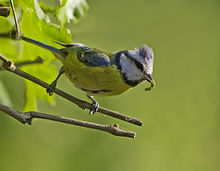
The tits are generalistinsectivoresthat consume a wide range of small insects and other invertebrates, particularly small defoliating caterpillars. They also consumeseedsand nuts, particularly in the winter. One characteristic method of foraging in the family is hanging, where they inspect a branch or twig and leaves from all angles while hanging upside down to feed.[5]In areas where numerous species of tit coexist, different species forage in different parts of the tree, their niche determined in no small way by their morphology; larger species forage on the ground, medium-sized species foraging on larger branches, and the smallest species on the ends of branches. Having obtained larger prey items or seeds, tits engage in hold-hammering, where they hold the item between their feet and hammer it with their bill until it opens. In this fashion, they can even openhazelnutsin around 20 minutes. A number of genera engage in food caching, hoarding supplies of food during the winter.[11]
Breeding
[edit]Tits are cavity-nesting birds, typically using trees, althoughPseudopodoces[12]builds a nest on the ground. Most tree-nesting tits excavate their nests,[13]andclutch sizesare generally large for altricial birds, ranging from usually two eggs in therufous-vented titof the Himalayas to as many as 10 to 14 in the blue tit of Europe.[14][15]In favourable conditions, this species had laid as many as 19 eggs, which is the largest clutch of any altricial bird.[3]Most tits are multibrooded, a necessary strategy to cope with either the harsh winters in which they reside in the Holarctic or the extremely erratic conditions of tropical Africa,[15]where typically a single pair cannot find enough food to rear even one nestling and in drought years breeding is likely to be futile.
Many African tit species, along withPseudopodoces,arecooperative breeders,[16]and even pair-breeding parids are often highly social and maintain stable flocks throughout the nonbreeding season.[17]
Tits also have a variety of methods for attracting mates, primarily through their intricate, bouncing mating dance. Only the blue tit is typically polygynous; all other species are generally monogamous.[18]Courtship feeding is typical of pair-breeding tits to deal with the cost of rearing their large broods.
Systematics
[edit]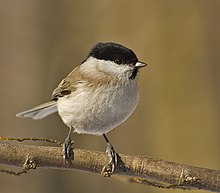
Recently, the largeParusgroup has been gradually split into several genera (as indicated below), initially byNorth Americanornithological authorities and later elsewhere. Whereas in the mid-1990s, onlyPseudopodoces,Baeolophus,Melanochlora,andSylviparuswere considered well-supported by the available data as distinct fromParus.[19]Today, this arrangement is consideredparaphyleticas indicated bymtDNAcytochromebsequenceanalysis, andParusis best restricted to theParus major—Parus fasciiventerclade,and even the latter species' closest relatives might be considered a distinct genus.[20]
In theSibley-Ahlquist taxonomy,the family Paridae is much enlarged to include related groups such as thependuline titsandlong-tailed tits,but while the former are quite close to the tits and could conceivably be included in that family together with thestenostirid "warblers",the long-tailed tits are not. Indeed, theyellow-browed titand thesultan titare possibly more distant to the tits than the penduline tits are.[20][21]If the two current families are lumped into the Paridae, the tits would be asubfamilyParinae.
Alternatively, all tits—save the two monotypic genera discussed in the preceding section and possiblyCyanistes,but including Hume's ground tit—could be lumped inParus.In any case, four major clades of "typical" tits can be recognized: the dark-capped chickadees and their relatives (PoecileincludingSittiparus), the long-crestedBaeolophusandLophophanesspecies, the usually tufted, white-cheekedPeriparus(includingPardaliparus) with more subdued coloration and finallyParus sensu stricto(includingMelaniparusandMachlolophus). Still, the interrelationship of these, as well as the relationships of many species within the clades, are not well-resolved at all; analysis ofmorphologyandbiogeographyprobably gives a more robust picture than the available molecular data.[20]
Tits have settled North America twice, probably at some time during the Early-MidPliocene.The first were the ancestors ofBaeolophus,with chickadees arriving somewhat later.[20]
Species in taxonomic order
[edit]| Phylogeny of the Paridae based on Johansson et al. 2013[22] |


Family: PARIDAE[23]
| Image | Genus | Living species |
|---|---|---|
 |
CephalopyrusBonaparte, 1854 |
|
 |
SylviparusBurton, 1836 |
|
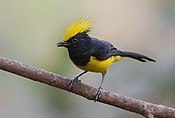 |
MelanochloraLesson, 1839 |
|
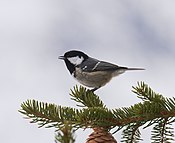 |
PeriparusSélys Longchamps, 1884 |
|
 |
PardaliparusSélys Longchamps, 1884 |
|
 |
LophophanesKaup, 1829 |
|
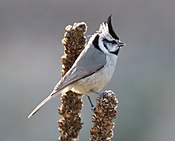 |
BaeolophusCabanis, 1850 |
|
 |
SittiparusSelys-Longchamps, 1884 |
|
 |
PoecileKaup, 1829 |
|
 |
CyanistesKaup, 1829 |
|
 |
PseudopodocesZarudny & Loudon, 1902 |
|
 |
ParusLinnaeus, 1758 |
|
 |
MachlolophusCabanis, 1850 |
|
 |
MelaniparusBonaparte, 1850 |
|
References
[edit]- ^ The Merriam-Webster New Book of Word Histories.Springfield, MA, USA: Merriam-Webster. 1991. p. 362.ISBN0-87779-603-3.
- ^Douglas Harper (© 2001-2015)."titmouse (n.)".Online Etymology Dictionary.Retrieved2015-04-28.
{{cite web}}:CS1 maint: numeric names: authors list (link) - ^abPerrins, C. (1991). Forshaw, Joseph (ed.).Encyclopaedia of Animals: Birds.London: Merehurst Press. pp. 202–203.ISBN1-85391-186-0.
- ^Gosler & Clement (2007) P.669
- ^abcdefgGosler, Andrew; Clement, Peter (2007). "Family Paridae (Tits and Chickadees)". In del Hoyo, Josep; Elliott, Andrew; Christie, David (eds.).Handbook of the Birds of the World. Volume 12: Picathartes to Tits and Chickadees.Barcelona: Lynx Edicions. pp. 662–709.ISBN978-84-96553-42-2.
- ^"Great Tits May be Evolving Bigger Beaks. Here's Why".19 October 2017. Archived fromthe originalon October 20, 2017.
- ^Kendra, Sewall (2015)."Social Complexity as a Driver of Communication and Cognition".Integrative and Comparative Biology.55(3): 384–395.doi:10.1093/icb/icv064.PMID26078368.
- ^Alpin, L. M.; Farine, D. R.; Morand-Ferron, J.; Cole, E. F.; Cockburn, A.; Sheldon, B. C. (2013). "Individual personalities predict social behaviour in wild networks of great tits (Parus major)".Ecology Letters.16(11): 1365–1372.doi:10.1111/ele.12181.hdl:1885/66143.PMID24047530.S2CID3400989.[dead link]
- ^admin (2022-08-15)."Tufted Titmouse - Best Facts 2022".Birds At First Sight.Retrieved2022-09-30.
- ^Templeton, Christopher; Greene, Erick; Davis, Kate (2005). "Allometry of Alarm Calls: Black-Capped Chickadees Encode Information About Predator Size".Science.308(5730): 1934–1937.Bibcode:2005Sci...308.1934T.doi:10.1126/science.1108841.PMID15976305.S2CID42276496.
- ^Jokinen, S; Suhonen, J (1995). "Food Caching By Willow and Crested Tits: A Test of Scatterhoarding Models".Ecology.76(3): 892–898.doi:10.2307/1939354.JSTOR1939354.
- ^"Pseudopodoces humilis, a misclassified terrestrial tit (Paridae) of the Tibetan Plateau: evolutionary consequences of shifting adaptive zones"[permanent dead link]
- ^Mönkkönen, Mikko and Orell, Markku; "Clutch Size and Cavity Excavation in Parids (Paridae): The Limited Breeding Opportunities Hypothesis Tested" inThe American Naturalist,Vol. 149, No. 6 (June 1997), pp. 1164–1174
- ^"List of Species and Data Sources Used for Geographic Distributions and Data on Clutch Sizes and Intrinsic Variables"
- ^abNewton, Ian;Population Limitation in Birds;p. 25.ISBN9780125173667
- ^Johannessen, Lars E. (2011). "Geographical variation in patterns of parentage and relatedness in the co-operatively breeding Ground Tit Parus humilis".Ibis.153(2): 373–383.doi:10.1111/j.1474-919X.2011.01115.x.
- ^Stacey, Peter B. and Ligon, J. David; "The Benefits-of-Philopatry Hypothesis for the Evolution of Cooperative Breeding: Variation in Territory Quality and Group Size Effects" inThe American Naturalist,Vol. 137, No. 6 (Jun., 1991), pp. 831–846
- ^Andersson, S; Rnborg, J; Andersson, M (1998)."Ultraviolet sexual dimorphism and assortative mating in blue tits".Proc Biol Sci.265(1395): 445–450.doi:10.1098/rspb.1998.0315.PMC1688915.
- ^Harrap, Simon & Quinn, David (1996):Tits, Nuthatches & Treecreepers.Christopher Helm,London.ISBN0-7136-3964-4
- ^abcdGill, Frank B.; Slikas, Beth; Sheldon, Frederick H. (2005). "Phylogeny of titmice (Paridae): II. Species relationships based on sequences of the mitochondrial cytochrome-b gene".Auk.122(1): 121–143.doi:10.1642/0004-8038(2005)122[0121:POTPIS]2.0.CO;2.S2CID86067032.
- ^Jønsson, Knud A.; Fjeldså, Jon (2006). "Determining biogeographical patterns of dispersal and diversification in oscine passerine birds in Australia, Southeast Asia and Africa".J. Biogeogr.33(7): 1155–1165.doi:10.1111/j.1365-2699.2006.01507.x.S2CID84542347.
- ^Johansson, Ulf S; Ekman, Jan; Bowie, Rauri C.K; Halvarsson, Peter; Ohlson, Jan I; Price, Trevor D; Ericson, Per G.P (2013). "A complete multilocus species phylogeny of the tits and chickadees (Aves: Paridae)".Molecular Phylogenetics and Evolution.69(3): 852–860.doi:10.1016/j.ympev.2013.06.019.PMID23831453.
- ^Gill, Frank; Donsker, David (eds.)."Waxwings and their allies, tits & penduline tits".World Bird List Version 6.1.International Ornithologists' Union.Retrieved15 February2016.
- ^James, H. F. et al. (2003).Pseudopodoces humilis,a misclassified terrestrial tit (Paridae) of the Tibetan Plateau: evolutionary consequences of shifting adaptive zones.Ibis145: 185–202.pdf fileArchived2006-09-21 at theWayback Machine
External links
[edit]- Titmouse photos & videoson the Internet Bird Collection
